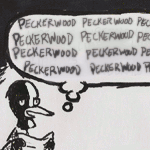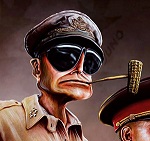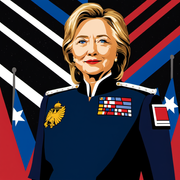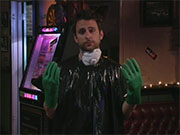|
SeanBeansShako posted:Remember that warfare is universally pretty horrible? well, it is time to depress you with what I call 'The How does he know what happened on the ship?
|
|
|
|

|
| # ? May 26, 2024 17:35 |
|
British nobles can smell commoners drinking brandy that is much too good for them from 100 nautical miles. Plus it did mention 20 people survived.
|
|
|
VanSandman posted:How does he know what happened on the ship? EDIT: Turns out with a bit of light search internet work he was a fictional French sailor written by British Midshipman John Pollard who did serve on HMS Victory. I'm not making this up. What. Always double check the sources. SeanBeansShako fucked around with this message at 06:46 on Nov 20, 2013 |
|
|
|
|
Unluckyimmortal posted:Is the degree of tumblehome represented on that Dutch frigate accurate for the time, or is it just kinda amateurish perspective? It's accurate. Wikipedia posted:Tumblehome was common on wooden warships for centuries. In the era of oared combat ships it was quite common, placing the oar ports as far abeam as possible. This also made it more difficult to board by force, as the ships would come to contact at their widest points, with the decks some distance apart. The narrowing of the hull above this point made the boat more stable by lowering the weight above the waterline, which is one of the reasons it remained common during the age of cannon-armed ships. In addition, the sloping sides of a tumblehome ship increased the effective thickness of the hull versus flat horizontal trajectory gunfire (a straight line through faced more material to penetrate) and increased the likelihood of a shell striking the hull being deflected—much the same reasons that later tank armor was sloped.
|
|
|
|
count_von_count posted:A few pages ago, but this is my favorite u-boat sinking as well. Also, the "someone on board" who flushed improperly was the boat's commander KL Karl-Adolf Schlitt. So it was a complicated ventilation/evacuation scheme where you had to activate all the switches in the correct order, and then somewhere, at the wrong point in the sequence, Schlitt hit the fan?
|
|
|
|
Imagine how stupid he must have felt.
|
|
|
|
I think I mentioned this in the earlier thread, but the Japanese ops planning was really haphazard at Midway. For instance, Nagumo was aware of that it would probably be a good idea to recon beforehand to find out where the US carriers are. The idea was to use Emily flying boats from the Marshall Islands, refuel them at French Frigate Shoals from a sub and then look for the carriers. At the time, there was an American seaplane tender at the French Frigate Shoals so the whole recon op got scrubbed.
|
|
|
|
I think I'm going to treat myself to Shattered Sword as an early Christmas present.
|
|
|
|
|
SeanBeansShako posted:I think I'm going to treat myself to Shattered Sword as an early Christmas present. I think that it is a good suggestion for people who just have even a passing interest in the Pacific. It is very well written and while there are some segments that do go into the engineering of ships etc., the conclusions from those bits are integrated smoothly into the narrative and if you don't want to read all the spergy bits you don't have to. It is also very accessible in the sense that you can go in knowing very, very little about the Pacific theatre (as in common knowledge basic), and the authors guide the reader through very clearly. It really is a very well put together history book, regardless of the subject. As a Christmas gift (for yourself or for someone else) its a solid choice for anyone who's not intimidated by a history book.
|
|
|
|
They also have a book about Surigao strait that's worth reading.
|
|
|
|
Hornfischer's Last Stand Of The Tin Can Sailors is also worth a read. It's about the Battle off Samar which was talked about a page back.
|
|
|
|
Or if you don't have time for that, watch the death of the Japanese navy episode of dogfights. It's pretty much the made for TV movie version of last stand of the tin can sailors.
|
|
|
|
How effective is chainmail at protecting from early firearms? Less so than plate armor?
|
|
|
|
I'm sure you'd get more bent little bits pushed horribly into the newly introduced gaping hole in your torso.
|
|
|
|
|
Farecoal posted:How effective is chainmail at protecting from early firearms? Less so than plate armor? Mail wasn't designed to deal even with arrows. Consider that it's basically a lot of tiny holes connected with each another. It's easy for any sufficiently powerful projectile to find a way through. Increasing density and sophistication of riveted / welded joints can marginally improve effectiveness in this area while making the mail overall less practical. Mail has seen application in modern cwarfare, including in protective headgear of some tank crews, but most often not to protect against bullets - rather as a form of anti-shrapnel protection, or to add a layer of blade resistant material underneath bullet resistant, but easily shredded fabrics.
|
|
|
|
Farecoal posted:How effective is chainmail at protecting from early firearms? Less so than plate armor? Depends on how strong the shot is, ultimately, but the fact that you have thick padded backing behind it is the only reason it could be effective. There is a buff coat or some other kind of padded armour from the 17th century in the Kelvingrove Art Gallery & Museum that has a bullet mark in it, so clearly there were some types of shot that could be received. But this was not really a function of the mail itself, and by the time gunpowder became a serious threat most mail was tempered steel, not iron, and thus more prone to snap making it more challenging to "catch" the actually ball in the way that modern body armour and buff coats do. steinrokkan posted:Mail wasn't designed to deal even with arrows. Consider that it's basically a lot of tiny holes connected with each another. It's easy for any sufficiently powerful projectile to find a way through. Increasing density and sophistication of riveted / welded joints can marginally improve effectiveness in this area while making the mail overall less practical. Mail has seen application in modern cwarfare, including in protective headgear of some tank crews, but most often not to protect against bullets - rather as a form of anti-shrapnel protection, or to add a layer of blade resistant material underneath bullet resistant, but easily shredded fabrics. Mail was indeed designed to deal with arrows. It would not do to have an armour that could not cope with one of the most common threats on the battlefield, and other pointed weapons like spears and swords would pose similar problems. This article: http://www.myarmoury.com/feature_mail.html will be of interest to you.
|
|
|
|
Rodrigo Diaz posted:There is a buff coat or some other kind of padded armour from the 17th century in the Kelvingrove Art Gallery & Museum that has a bullet mark in it, so clearly there were some types of shot that could be received. But this was not really a function of the mail itself... Although, considering the low muzzle velocity of the period, mail would be more likely to stop a bullet than it would be today...
|
|
|
|
a travelling HEGEL posted:Not to mention the low muzzle velocity of the period and the fact that we have no idea what that bullet had been doing before it hit that guy. It could have been a ricochet, it could have been almost spent, it could have been doing any number of things. Also the typically wider diameter of the bullet, the round shape, and the lack of a copper jacket. That isn't to say this is typical, of course! For a rather more successful bullet, though still not totally, consider if you will Götz of the Iron Hand. Gives you a good sense of the power of gunpowder arms in the period.
|
|
|
|
I'm sorry if this has come up before but I'm lazy. What's the real deal with Roman infantry formations, manuevers and so on? I remember reading that the soldiers were divided into three lines, consisting of the rookies at the front, the hardened veterans behind, and the Triarii, the old hands, at the rear. This makes sense because you don't want your valuable troops to die pointlessly in the initial salvo, plus it helps turn the new guys into veterans really quickly. Then the veterans (can't remember the other two names sorry) are the meat of the fighting force, and the Triarii were the reserves sent in when things seemed desperate and level heads were needed. What I'm curious about is how this was actually achieved. Were individual centuries or maniples moving around as big blocks? Or did individual men move past eachother? It seems really messy and I don't see any right answer, but it's been ages since I read up on this. It seems like if the enemy were one continuous mass of men, which they often were, suddenly having every second brick of your army disappear and start doing parade drills would be...detrimental. I find the Roman military really fascinating because of how far they predate other 'professional' armies, and how logical and sensible their command structure and logistics were.
|
|
|
|
|
Funky See Funky Do posted:What did the Indian army look like just prior to the British takeover? I suppose it's part of a larger question about the early gunpowder era. Which armies didn't adopt the technology and why? First off; India was not, strictly speaking, unified, but the Maratha Empire / Confederacy / Vaguely State-Like Conglomeration held most of the non-Bengal bits of the modern state of India to varying degrees of efficiency when the British started making their real push to devour everything in their path. They actually had pretty alright and Europe-like musket tactics, as I recall, at least by the third and last real Anglo-Marathi War; someone else can cover it in more detail, I'm sure, but they certainly adopted firearm technology with some gusto, and their artillery (when not hampered by political infighting... so not very often) was about as able to deliver "ehh, fire grapeshot that way and hope for the best" as your typical mediocre European state. Also, elephants, although there are anecdotes of them not meshing especially well with gunfire. It was their logistics and political fractiousness that wrecked them (and made them vulnerable to Britain's favored divide-and-conquer strategy) more than any fundamental flaws in war doctrine; there's a story that some of the key players in the Second Maratha War outsourced their ammunition acquisition to British allies. I'm a little surprised their navy got rolled so readily, though, so maybe someone can expound on that. Maratha relied heavily on its coastal control and movement, especially as compared to - for example - the Mughals.
|
|
|
|
Rodrigo Diaz posted:Also the typically wider diameter of the bullet, the round shape, and the lack of a copper jacket. Plus the firearms of that period didn't have the range of later weapons, and there wasn't the sustained volley fire that comes later. Mail may not have been perfect, but that match or wheel lock user better be damned accurate or he's going to have a pissed off mail wearer in his face pretty quickly.
|
|
|
|
Are there any good books/anyone who knows interesting things about the Second Congo War? Most of the stuff I've seen is pretty dry and nonspecific, basic things like the leadup to the war, its relation to the genocide in Rwanda, things like that, which has always struck me as kind of strange for the bloodiest war post-WW2.
|
|
|
|
Slavvy posted:I'm sorry if this has come up before but I'm lazy. It depends on what sources you go by, but the formation, called the Quincunx, was generally deployed with the hastati manipules in the front, with wide spaces between them, the principes manipules behind them, covering the gaps, and the triarii either in a solid line or in a similar formation with gaps. This meant that units could, in theory, fall back in good order through the line behind them. It's a lot more likely that the line behind could advance as cohesive manipules. The Quincunx formation allowed the youngest men in the best physical shape to tire out the enemy, gain some experience, and have a fairly safe route back through a line of veterans once they started to tire or panic. In the time frame of the Camillan and Polybian military systems, this was used to fairly good effect against a bunch of different enemies of Rome. As far as the question of parade drills go, some of Rome's greatest military strengths related very strongly to drill and marching. Much of the history of Rome's military victories is of smaller forces of Romans destroying much larger numbers of non-Romans. There's surely some exaggeration going on, but think about it this way -- you've got a huge blob of men that you just aim at the enemy and tell them to charge. They get snarled up on the front ranks and lap around the sides of the blocks of enemy soldiers, failing to gain ground because they're in square formation. It turns into a grinding slog. None of your men are resting, and you have effectively very little tactical control over them. Suddenly, most of the enemy's front line begins to fall back in fairly good order. They pull back, and though your men are tired they give chase, straight into a second line of veterans, who have been waiting for the opportunity. That's when things start to get ugly. However, the Roman military also had a huge political problem, in that armies tasked to actually fight a war tended to be lead by any given year's Consuls. If you have a good general, you're almost certainly not going to have him next year. For every Gaius Marius (who destroyed the Germans), Rome ended up stuck with a Quintus Servilius Caepio (who managed to lose 120,000 men to them, including an army he didn't even command). Rome took one hell of a beating against the Germans because they basically kept giving the top command to bumblers, so at least in that regard, their command structure had some major problems. Rodrigo Diaz posted:Mail was indeed designed to deal with arrows. It would not do to have an armour that could not cope with one of the most common threats on the battlefield, and other pointed weapons like spears and swords would pose similar problems. This article: http://www.myarmoury.com/feature_mail.html will be of interest to you. I would be interested to see tests of historical and modern produced mail against spear thrusts though, I find myself a lot more skeptical of mail's ability to resist a solid spear thrust, although the article you linked does have some slightly frightening anecdotes: quote:...the horseman who struck Philip the knight, for verily the Franks have all been astounded on account of that blow which pierced two layers of links (back and front) in the knight's coat of mail and did not kill him. No bid COVID fucked around with this message at 08:25 on Nov 21, 2013 |
|
|
|
quote:However, the Roman military also had a huge political problem, in that armies tasked to actually fight a war tended to be lead by any given year's Consuls. If you have a good general, you're almost certainly not going to have him next year. For every Gaius Marius (who destroyed the Germans), Rome ended up stuck with a Quintus Servilius Caepio (who managed to lose 120,000 men to them, including an army he didn't even command). Rome took one hell of a beating against the Germans because they basically kept giving the top command to bumblers, so at least in that regard, their command structure had some major problems. In fairness though this isn't *that* ridiculous, unless the requirement to have something like 20 years of military service to be eligible to be Consul was waived before Caepio's time? How was military tactics training? Did Rome have anything like a 'High Academy of Military Science', something like West Point to train all of their cadres or was that something that didn't kick in until the 18th century? Seems like the problem with incompetent Consuls could've been partly averted if they had to go through a thorough course in strategy.
|
|
|
|
SpaceViking posted:Are there any good books/anyone who knows interesting things about the Second Congo War? Most of the stuff I've seen is pretty dry and nonspecific, basic things like the leadup to the war, its relation to the genocide in Rwanda, things like that, which has always struck me as kind of strange for the bloodiest war post-WW2. Was it ever reported on in any serious fashion by Western media? edit: Seriously, its blowing my mind that almost no one has heard of this despite how unbelievably violent it was. Cumshot in the Dark fucked around with this message at 10:31 on Nov 21, 2013 |
|
|
|
Raenir Salazar posted:How was military tactics training? Did Rome have anything like a 'High Academy of Military Science', something like West Point to train all of their cadres or was that something that didn't kick in until the 18th century? You probably went out to join an older magistrate's army somewhere out in the provinces to learn from them, both to learn how to run a war and to get some military experience which was seen as more or less obligatory for a political career.
|
|
|
|
Slavvy posted:I'm sorry if this has come up before but I'm lazy. I will note that this applied only to the earlier armies of the Roman republic. The late Roman republic, and the Roman empire, from which most of the main lopsided victories date, discarded the hastati-principi-triari system.
|
|
|
|
Not quite. The experience thing was still there, but the difference between the hastati and the triarii greatly diminished because the Roman army became more professional - the greener guys were still at the front, but they were usually not completely green. It became more of a seniority thing. What did happen was that they discarded the equipment differences - all three ranks were supposed to have more or less the same gear, while in the old system the triarii used spears rather than swords, for example. I have a probably out of print book on the subject with a couple of nice diagrams of legionary formations in Caesar's time, is it OK if I scan those and post them here, or would it be considered
|
|
|
|
Tevery Best posted:I have a probably out of print book on the subject with a couple of nice diagrams of legionary formations in Caesar's time, is it OK if I scan those and post them here, or would it be considered Edit: If you're really worried, though, you should probably ask a mod rather than some random person on the internet. HEY GUNS fucked around with this message at 11:18 on Nov 21, 2013 |
|
|
|
If it's old enough and public domain I really don't see why not. Just don't go posting maps unique to Shattered Sword or something.
|
|
|
|
What was a commander's role during the actual battle in the pre-modern era? Did they participate in the actual battle or did they stay way behind the lines? How did they direct maneuvers, or were lower level commanders mostly autonomous? Guys like Richard III and Harold II died during the battle, so I assume some commanders at least got involved in the actual fighting, but it seems to me like if you are fighting for your life, you can't really issue commands. So was it more a situation where you just pointed your armies at each other, told your subordinates what to do, and then just let it play out?
|
|
|
|
zoux posted:What was a commander's role during the actual battle in the pre-modern era? Did they participate in the actual battle or did they stay way behind the lines? How did they direct maneuvers, or were lower level commanders mostly autonomous? Guys like Richard III and Harold II died during the battle, so I assume some commanders at least got involved in the actual fighting, but it seems to me like if you are fighting for your life, you can't really issue commands. So was it more a situation where you just pointed your armies at each other, told your subordinates what to do, and then just let it play out? Keep in mind that during the Middle Ages, armies fought because of a personal relationship between Lord and Vassal. If you wanted to keep your army in the field, you had to be there because that was part of the deal. But for most of history, Command & Control weren't really things that happened during the battle. You deployed your army, made sure that everyone had a basic idea of what you wanted to do, and then you let it play out.
|
|
|
|
On a lazy day in camp outside the Pleissenburg in Leipzig in 1631, somebody made some sketches (with watercolor They're very thin.  Also of note is the distinctive early modern German/northern Italian/English fortification style--the Pleissenburg was rebuilt after 1547, when the building which had stood there earlier was damaged in the Schmalkaldic War, making this fortress already out-of-date at the time the sketch was made. Edit: Whoever did this writes well--look at the display script on the top right corner. I wonder who he or she was? HEY GUNS fucked around with this message at 20:32 on Nov 21, 2013 |
|
|
|
zoux posted:What was a commander's role during the actual battle in the pre-modern era? Did they participate in the actual battle or did they stay way behind the lines? How did they direct maneuvers, or were lower level commanders mostly autonomous? Guys like Richard III and Harold II died during the battle, so I assume some commanders at least got involved in the actual fighting, but it seems to me like if you are fighting for your life, you can't really issue commands. So was it more a situation where you just pointed your armies at each other, told your subordinates what to do, and then just let it play out? While the romantic picture likes to paint them in front of the lines leading the men in reality most commanders stayed behind and barely had any control. If they were especially competent they might find a hill to sit on and order reserves around. Even the famous cavalry charges that cost quite a few lives did not happen nearly as often as depictions would make you think. Commanders definitely were near battles though, since them being there played a huge part in actually keeping armies loyal and creating propaganda opportunities.
|
|
|
|
zoux posted:What was a commander's role during the actual battle in the pre-modern era? Did they participate in the actual battle or did they stay way behind the lines? How did they direct maneuvers, or were lower level commanders mostly autonomous? Guys like Richard III and Harold II died during the battle, so I assume some commanders at least got involved in the actual fighting, but it seems to me like if you are fighting for your life, you can't really issue commands. So was it more a situation where you just pointed your armies at each other, told your subordinates what to do, and then just let it play out? It depends. Staying behind the lines, giving orders, is one of the advantages of the Mongols and the Romans over their enemies. However, participating in the battle yourself for many less professional armies is one of the main way leaders could motivate their men.
|
|
|
|
Didn't the hilarious War of 1812 stall for the British in the North because they lost two pretty decent Commanders to Rifle fire because they led from the front?
|
|
|
|
|
 (click) Yes.
|
|
|
|
Just think of the history we wouldn't have lost if Nelson played it slightly more safe too. All the other limbs he could have lost, all the chances to treat his wife terribly and all the upper class cuckolding scandals lost too.
|
|
|
|
|
Koramei posted:
Kate Beaton always makes me giggle like an idiot. "This may not be a great thing for Spain" pops into my head every now and then and I lose it. This is great too: http://www.harkavagrant.com/index.php?id=345 Also, glad to see Rodrigo Diaz hasn't driven you off. His style used to be a great deal more...muscular. He's toned it down.
|
|
|
|

|
| # ? May 26, 2024 17:35 |
|
It's funny because it was today's Beaton that got me thinking about a commander's role in medieval militaries!
|
|
|





























